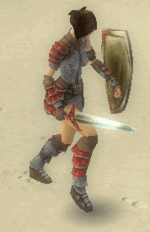Kite
To kite is to use movement to avoid enemy damage. Melee characters (such as warriors, dervishes, and melee ranger builds such as touch rangers and thumpers) deal a great amount of damage, especially to targets with low armor class. However, since they can only deal this damage at close range, the pressure from a melee character can be mitigated via kiting.
Ranged kiting[edit]
Ranged attacks and projectile spells can also be successfully kited. In addition, many projectiles can be avoided via moving in a zig-zag pattern or rapidly strafing back and forth — this is known as dodging. Projectiles can be blocked by in-game objects (such as walls, rocks, the undersides of bridges, etc.). So, a player can successfully avoid projectile damage by moving behind one of these objects.
It is significantly easier to kite projectiles with mouse movement than keyboard movement due to the movement speed penalty for sidestepping and backpedaling.
Area of effect damage, such as that from Searing Flames, can be partially mitigated via team members kiting in different directions -- sometimes referred to as scattering.
Pre-kiting[edit]
Observant players will pre-kite dangerous enemies. Pre-kiting simply means moving away from an enemy before that enemy is in range to begin dealing damage. For example, if a backline character sees a warrior approaching, they would be wise to begin running away (or calling for melee hate).
Kiting and "fleeing"[edit]
When kiting, a player will usually move directly away from melee ranged enemies -- often traveling towards the friendly back-line. However, moving directly away from a melee enemy exposes a player's back to the enemy unless backpedaling. This status is known as fleeing and results in drastically more critical hits against melee.
With wards[edit]
When wards such as the Ward Against Foes or Ward Against Melee are used, kiting is often performed as a wide circle around the perimeter of the ward (or sometimes cutting through its center). Wards are sometimes positioned in an figure eight pattern to create more area to kite in. Certain necromancer wells, such as the Well of Darkness or Well of Profane, can also be used as areas to kite through and around.
Aids/counters[edit]
Many skills can aid or hinder the kiting ability of a character, as well as help the character chasing the kiter.
- counter kiting
- Knockdowns such as Gale or Devastating Hammer can prevent enemies from kiting or chasing for a short period of time.
- Snaring an enemy makes it easier to run from or chase down that character.
- A teammate could Body block the chasing character to help their ally.
- Shadow stepping can immediately bring you to your intended target, with no chance of pre-kiting.
- improve kiting
- Skills like Balanced Stance can help prevent knockdowns. In addition, Balanced Stance will also prevent critical hits from skills striking a fleeing character.
- Speed boosts (IMS) such as Dark Escape and Storm Djinn's Haste allow kiting characters to move faster than their attackers, which will effectively mitigate damage from any melee-range characters.
- Stances, such as Zojun's Haste and Natural Stride, can increase both your movement speed and your chance to block attacks. This is especially helpful when trying to move through an area quickly in which monsters use skills that inflict the crippled condition.
- Shadow steps skills such as Return can also bring you suddenly out of harm's way.
Trivia[edit]
- The term "kiting" comes from the path that NPC enemies follow when they blindly chase a running player, which is similar to that of a towed kite. It may have originated in games where towing NPCs around very large areas was a useful battle tactic. When applied to ranged attack dodging, it could also be said to refer to the unpredictable movement of an actual kite.
